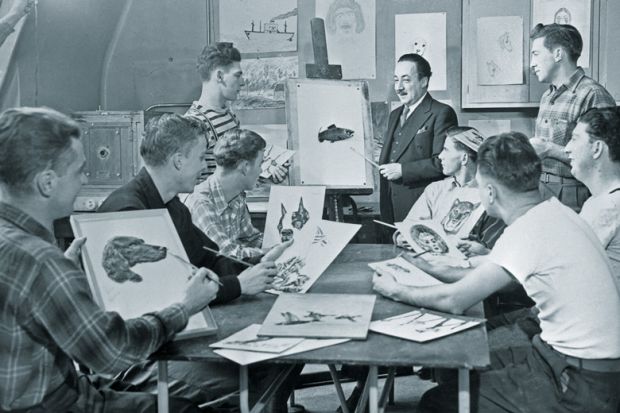There are two main types of writing about universities and their history. There is the agonised complaint that something precious is being lost – these are books about the university in crisis or in ruins. The ideals of higher education are supposed to have been betrayed by an unholy trinity of managers, markets and ministers. And then there is a very different history, which is all about growth, progress and development. This book is unapologetically in the latter camp. It is an affectionate if rather uncritical narrative history of the rise of America’s elite universities. James Axtell explicitly eschews engaging with awkward issues from marketisation to student protests (in this book, as they say, the 1960s do not happen; instead you have the 1950s twice).
It is an example of what Herbert Butterfield identified as the Whig interpretation of history – writing “to impose a certain form upon the whole historical story, and to produce a scheme of general history which is bound to converge beautifully upon the present – all demonstrating throughout the workings of an obvious principle of progress”.
University history is one of the few genres in which this type of history survives. One can see why: it is indeed a story of expansion in which more people are brought into higher education, just as classic Whig political history was about the growth of the electorate and the rise of parliamentary democracy. And even as the number of the world’s universities expands to 10,000 and beyond, UK and US universities still stand at the top of league tables such as those produced in these pages by Times Higher Education. If we cannot be proud of our universities, then there really is not much we can be proud of.
Axtell goes right back to the beginning with a well-informed account of the medieval university. There is a chapter on the Oxbridge model with detailed assessment of issues such as the claims of Emmanuel College, Cambridge to be the progenitor of Harvard. Axtell demonstrates how many colleges sprang up across the English colonies of New England, often with teacher training as their primary role, and also how small and vulnerable they were. But he fails to cover another crucial way in which Oxbridge acted as a stimulus for the creation of the Ivy League – the Anglican monopoly of higher education in England meant that many English dissenters put their energies into helping to create and endow American institutions instead. Eighteenth-century Harvard was getting a third of its funding from England.
Perhaps the most powerful chapter brings out just how much influence German universities had on the emergence of the American research-intensive university. It is not just that Johns Hopkins was founded in the 1870s explicitly on the Humboldtian model of a research university. Axtell brings out just how broad and deep were the contacts with Germany, and how going to Germany to study for a doctorate was the best way for an American to advance an academic career. He sees the US graduate school, one of the exceptional strengths of the American universities, as a development of the German model. We finally created the doctorate in England to provide an alternative option for American students during and after the First World War.
He is also good on the GI Bill – the Servicemen’s Readjustment Act of 1944, to give it its formal title. This really was a profound event in the emergence of the American university. Many of the returning veterans went to America’s elite universities. In 1946, ex-servicemen made up 4,000 of Harvard’s 5,400 recruits. They changed the character of US universities for the better as they refused to participate in some of the more absurd initiation rituals that still baffle foreign observers of US universities. They are now called the “greatest generation”, and one reason is that they were more civic-minded than any generation before or after. I believe that one reason for this is their sense of obligation to give something back after they were granted this unexpected opportunity.
The surge of US veterans into higher education after the war also fuelled America’s post-war boom. For most of the 20th century, the rise of America and the rise of its universities went in parallel. They were mutually dependent: research-intensive universities and a host of well-educated students were rightly recognised as crucial to America’s greatness. Indeed, the 1958 legislation providing for the expansion of student numbers and loans was titled the National Defense Education Act.
The Harvard-based economists Claudia Goldin and Lawrence Katz have shown how the post-war US delivered sustained increases in the number of graduates to match the hunger of US employers for new recruits who could keep up in that race between education and technology. But all that is changing. Although the proportion of America’s young people entering higher education is quite high, the number who are actually graduating is falling behind those of key competitors. One reason why America’s great motor of a growing and prosperous middle class is now seizing up is that the growth of university graduation rates has stalled. The US is no longer the world leader in education that it once was. An optimistic book such as this ought to face this challenge and at least urge the US to rediscover that commitment to ever-wider access to higher education that was such a distinctive feature of the country in the 20th century.
These elite universities are part of a wider ecosystem. They cannot flourish in isolation. They need two-year colleges that can spot talent and, using credit transfer, enable students to move on to an honours degree elsewhere or to graduate school. Axtell, like so many British critics, is an admirer of Clark Kerr and the University of California system that he led from 1958 to 1967. But the well-defined roles of different institutions in Californian higher education are fixed by the state’s Board of Regents, who have the power to allocate research responsibilities and set admissions policies for the individual universities. England is much more liberal than this, with far more autonomy for our universities and no such power for anyone to set such roles in the system. There is indeed a trade-off between diversity and autonomy that the book might have considered.
As this book is unashamedly about the institutions that educate America’s elite, it would have been good to learn more about the development of their admissions practices. They are explicit about their ambition to provide America’s leaders, and this has led them to recruit on criteria that go way beyond simply academic aptitude. (A senior figure at one Ivy League university told me that if they simply recruited students with the highest SAT scores, they would just be producing middle-ranking programmers for IBM, not America’s leaders.) The ethics and the practice of “molding the class” remain one of the crucial differences between recruitment to prestigious universities in the US and England.
This is an enjoyable and well-informed account of some of the most significant universities in the world. But its comforting syrup leaves one wanting something rather more astringent.
Lord Willetts is visiting professor at King’s College London. He was minister for universities and science from 2010 to 2014.
Wisdom’s Workshop: The Rise of the Modern University
By James Axtell
Princeton University Press, 416pp, £24.95
ISBN 9780691149592
Published 23 March 2016
The author
 James Axtell, Kenan professor of humanities emeritus at the College of William and Mary, was born in Endicott, NY, “but raised, for a short time, on my grandparents’ farm, in Sidney, NY (45 miles away) after my parents’ divorce. I’ve loved animals ever since.”
James Axtell, Kenan professor of humanities emeritus at the College of William and Mary, was born in Endicott, NY, “but raised, for a short time, on my grandparents’ farm, in Sidney, NY (45 miles away) after my parents’ divorce. I’ve loved animals ever since.”
A “curious kid who liked school and learning”, he had “several excellent teachers along the way, especially an oldfashioned English teacher for my final two years of high school. Lydia Metz was a tough grader but a perfectionist who gladly read rewrites. I became the same kind of professor.”
He was admitted to Yale University “with middling verbal and higher math SAT scores, and notable talents in track and basketball. I had also covered our school sports for two local newspapers and all the school publications. My fondness for energetic adverbs and adjectives had to be trimmed by my freshman philosophy professor.
“In general, my academic background in a small upstate high school left me feeling unprepared but determined to compete with Yale’s many prep-school grads. By senior year I had surpassed most of them in class and all of them on the track, where I competed successfully in the long jump and triple jump.” He pursued a doctorate in history at the University of Cambridge, and while there broke a 41-year British universities record set by Harold Abrahams, whose story was told in the film Chariots of Fire.
Axtell’s retirement in 2008 “hasn’t changed my approach to scholarship much, except that it has allowed me to pursue larger topics – like university history over 800 years – full-time. It still takes me 5 to 6 years to finish a book’s research and writing.”
Asked which scholarly authors he commends for the clarity and elegance of their prose, he says, “I’ve always admired scholarly models who are productive and stylish writers, Edmund Morgan and John Blum (whose classes at Yale I never took!) being perhaps the first. Since then, the list is too long.”
After studying the academy’s past in such depth, can he be drawn on its future? “I’m very hopeful and confident that the university (generic) will adapt to changing times and continue to thrive and serve its various publics, despite the ‘gloom-and-doom’ critics and ‘disrupters’ who predict its superannuation or demise.”
Karen Shook
后记
Print headline: America’s power generators




